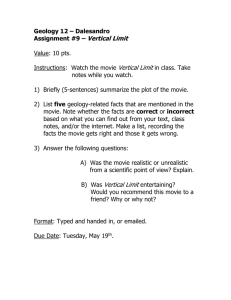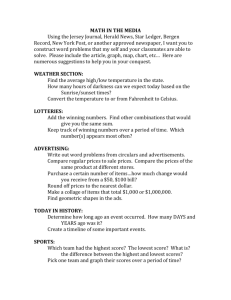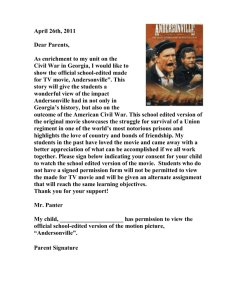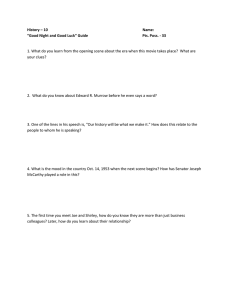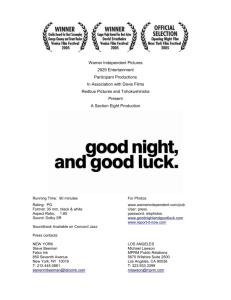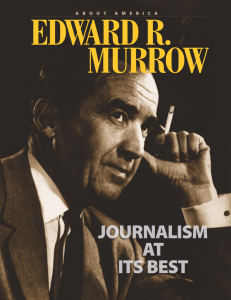Movie Assignment/ Essay 2 - Gmu
advertisement
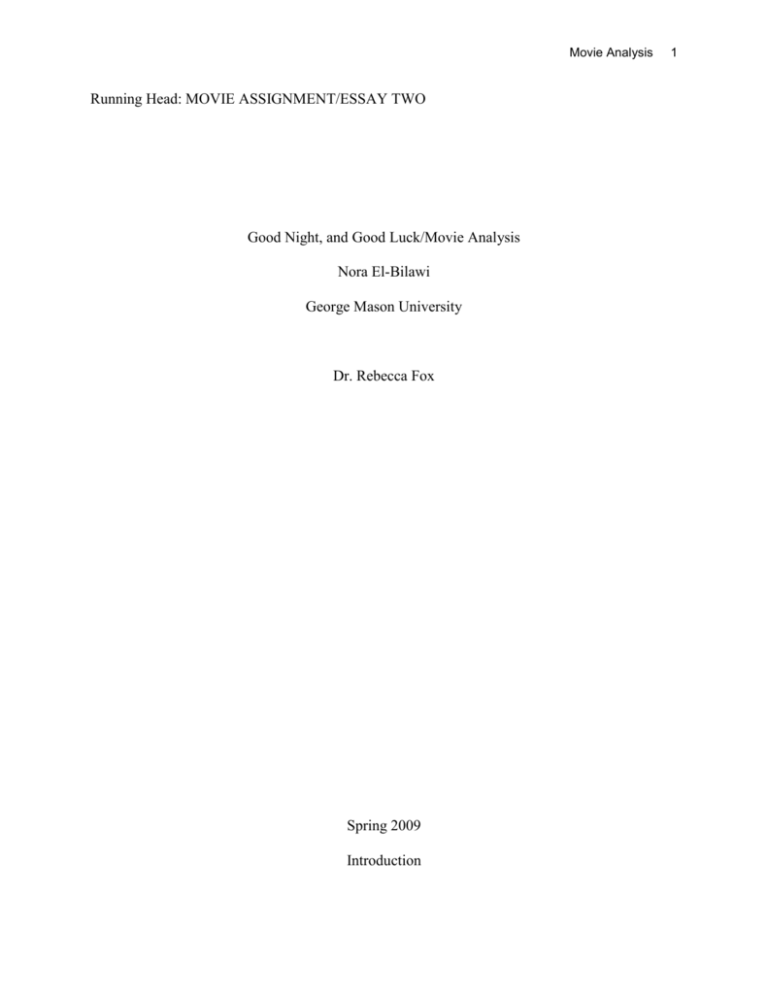
Movie Analysis Running Head: MOVIE ASSIGNMENT/ESSAY TWO Good Night, and Good Luck/Movie Analysis Nora El-Bilawi George Mason University Dr. Rebecca Fox Spring 2009 Introduction 1 Movie Analysis 2 Debrief of the Movie The name of this movie Good Night, and Good Luck refers to a motto used by media and CBS anchor Edward R. Murrow in the 1950s. At this time, media have been a typical fin de siècle decade in at least one important respect: The realm of media was on the brink of a profound transformation. The transformation occurred when the conflict around the role of media raised as whether it is the maker of news or the reporter of them. The movie argues that the media could be a well used tool or subject to be misused. The deregulation of media ownership, the privatization of television in lucrative American, European and Asian markets, and new communications technologies have made it possible for media giants to establish powerful distribution and production networks within and among nations in an attempt to control the world’s public opinions (Matthew Schwartz, 2008); who benefits from all that but the media owners, making business out of manipulated news, and their governments--to justify and market their own political agendas. Murrow’s message at the finale scene in the movie concludes that perhaps now more than any other time in human history, objective media is desperately needed—media to inform the masses; to provide voice to the voiceless; and to function as the objective counterweight that scrutinizes the powers that be. Leadership Presentations In the realm of that charged conflict around what the actual role of media is, two important figures were presented to illustrate different perspectives, styles, and methods of leadership in tackling media and its discourse analysis. These two leaders challenged each other with the power of media discourse that construct representations of the world, social relationships, and social identities and emphasized on practices and texts that are ideologically shaped by relations of power (Luke, 1997). Movie Analysis 3 Leadership Analysis The movie had several leadership examples; howver, the most two important axes in the moview were the charaters of Edward R. Murrow and Sen. Joseph McCarthy. Linking the actions that Murrow McCarthy took throughout the incidents in the movie with our course readings I will analyze their leadership methods in relation to Machiavelli, Hanh, Fullan, and Gardner. Leadership form our Reading Lenses Edward R. Murrow Hanh. The movie starts with Murrow’s dissatisfaction with most of the quality and the type of news that his network was pushing him to present; all what mattered to the network is to sell what they think people want and it was in fact serving their interests that was interwoven with the corporate America’s. Murrow had the diligence to fight the sufferings that capitalism, wealth, and fame brought to people who fought for its sustainability regardless the existence of the “others.” He inspired his whole team in working collaboratively towards a well designed goal that is to fight media contention. Murrow’s inner power enabled him to strongly fight back and never be hesitant on what he believed in. Fullan. Murrow had clear moral purpose when he stated “the fault is not in our stars but in ourselves...we can’t deny our heritage and can’t run from responsibility,” and when he defended the importance of the congressional committees in disputing accusations until there is a proof for conviction. Murrow was trying to bring a new culture of change by believing in it and implementing it in an ethical and patriotic message through the media venue; he was initiating courageously the responsibility of the media people in using news coverages as a tool of liberation, respect, and future determination. Movie Analysis 4 Gardner. Murrow’s ethical mind urged him to refuse that people with power can use media as a tool of mere intolerance to “others” and that accusations turn into convictions without respect to political agencies and social justices. He criticized his opponent’s disrespectful acts when he said“civilized people do not insist on agreement before discussion” disagreeing does not mean disrespect and that there must be controversies with no contaminations that is the essence of respecting each other as human beings. Sen. Joseph McCarthy Machiavelli. McCarthy is a typical representation of the Machiavellian leader who tries to manipulate people and events for his personal agenda. Power to him is by oppressing others and creating and spreading fear. He used his political intelligence in twisting realities and misusing his powers against any one who disagrees with him. McCarthy disregarded human decency, dignity, and rights by convictions of no bases. Discussion In this paper I tackled this movie essay from two different dimensional analysis; first, by providing a briefing analysis of the socio-political conflict that this movie is trying to zoom the light on. I view the main principles in this movie as: media’s discourse analysis, relation of discourse and power, and media as the tool in the hand of the voiced against the voiceless. Second dimension, is analyzing the leadership methods of the two key characters from the lens of our course readings of Machiavelli, Hanh, Fullan, and Gardner. Murrow’s message in Good Night, and Good Luck reflects a real leader of his age and all ages; he interconnected leadership with true power when he believed that he had to be the messenger of the Truth. References Movie Analysis 5 Fullan, M. (2001). Leading in a culture of change. San Francisco: Jossey-Bass. Gardner, H. (2008). Five minds for the future. Boston: Harvard Business Press. Hanh, T. N. (2007). The art of power. New York: HarperCollins. Luke, A. (1997). Theory and practice in critical science discourse. In L. Saha (Ed.), International encyclopedia of the sociology of education. Accessed April. 2009. http://www.gseis.ucla.edu/courses/ed253a/Luke/SAHA6.html Machiavelli, N. The prince. Classics Edition (2004). New York: Simon & Schuster, Pocket Books Division. Schwartz, M. (2008). Social media networking in 2009. Media Business Magazine, 86(6), 585.


